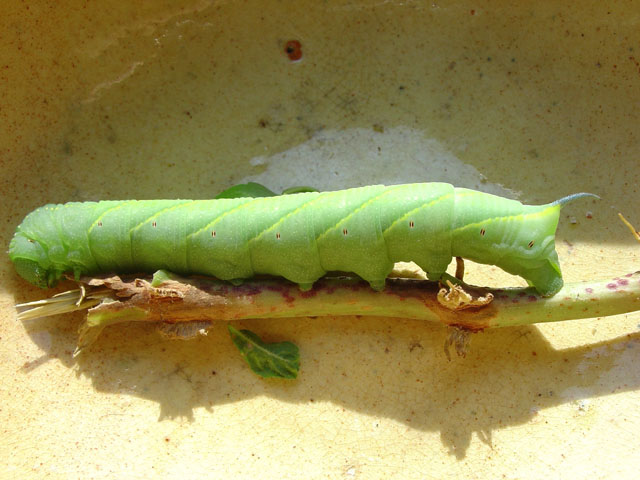Sphinginae subfamily
Sphingini tribe:
 |
Larvae feed on plants in the Convolvulaceae family, especially
Ipomoea batatas (sweet potato) and in the Solanaceae family,
especially (Datura) (jimsonweed) and related plants in the
Americas. There is also a brown form. Look for very large, dark
spiracular circles.
|
 |
Ceratomia amyntor
WO,
the Elm Sphinx or Four-horned Sphinx
Larvae feed on Elm (Ulmus), birch (Betula), basswood
(Tilia), and cherry (Prunus).
There are both green and brown forms. The four horns near
the head are diagnostic.
|
 |
Young caterpillars feed gregariously on Catalpa species
(Catalpa bignoniodes and C. speciosa) in the
Bignoniaceae family, skeletonizing the foliage.
Larvae are mostly white in early instars.
generally more eastern species
|
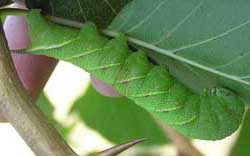 |
Ceratomia hageni
WO/, Hagen's Sphinx or Osage Orange Sphinx
Larvae feed on osage orange (Maclura pomifera), and they have a granulous appearance with variable amounts of purple
along the oblique white stripes.
|
 |
Fraxinus, Ligustrum, Quercus, Crataegus and
Chionanthus virginicus are listed as hosts.
In the fifth instar, the spiracular ovals are decidedly red and the
anal horn is off-white to pinkish laterally.
|
 |
Lintneria eremitoides WO. Larval hosts are Sage (Salvia species).
The Lintneria larvae will most often be encountered on Lamiaceae: Salvia (Sage), Mentha (Mints), Monarda (Beebalm) and
Hyptis (Bushmints); Verbenaceae: Verbena and Lantana camara (shrub verbenas or lantanas).
One is even more likely to discover larvae feeding in the evening or after dark.
|
 |
The caterpillars are called Tomato Hornworms and each has a black horn at the end of the abdomen.
Larvae feed on potato, tobacco, tomato, and other plants in the
nightshade family (Solanaceae).
|
 |
Tobacco Hornworms, equipped with a red-tipped horn at the end of the
abdomen, are true gluttons and feed on tobacco and tomato, and
occasionally potato and pepper crops and other plants in the
nightshade family (Solanaceae).
|
 |
Paratrea plebeja
AF , the Plebeian Sphinx
Preferred hosts are common trumpetcreeper (Campsis radicans),
Florida yellow-trumpet (Tecoma stans), lilac
(Syringa species), and
passionflower (Passiflora species).
The anal horn is blue, often preceded by a yellow dash.
The head is entirely green, without lateral bands of S. chersis.
|
Paratrea plebeja larva, Emporia, August 26, 2007, Antonia Felix
 |
Sphinx chersis
WO, the Northern Ash Sphinx or Great Ash
Sphinx. The larvae are pale bluish green. The head has a pair of
yellow lateral bands meeting at the apex. The oblique, lateral
stripes are pale and bordered anteriorly with a darker green.
Larval hosts are ash, lilac, privet, cherry, and quaking aspen.
|
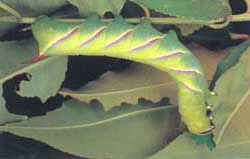 |
Sphinx drupiferarum larvae hide in the day and feed primarily on
cherry, plum, and apple at night.
Larvae have been found on Amelanchier nantuckensis in
Massachusetts and have been reared to pupation in Michigan on
Prunus serotina from eggs readily oviposited by a female.
possibly
|
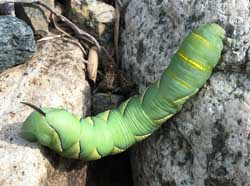 | Larvae feed on the common snowberry (Symphoricarpos albus)
and on coralberry (S. orbiculatus). Note the two golden
lines of slightly raised bumps, one just behind the head, the other
on the thorax.
|
Smerinthini Tribe:
 |
Amorpha juglandis larvae feed upon Walnut and butternut (Juglans),
hickory (Carya), alder (Alnus), beech (Fagus),
hazelnut (Corylus), and hop-hornbeam (Ostrya).
|
 |
Pachysphinx modesta
WO,
the Modest Sphinx or Poplar Sphinx
Larvae feed on poplars and cottonwood.
|
 |
Larvae accept willows, birches, and cherries.
I have also found them in the wild on oak in eastern Canada.
generally more eastern species
|
 |
Wild cherry species are the favorites as larval foodplants, but eggs
will also be deposited on birches and other forest trees.
To the left a second or third instar larva rests on pin cherry. The
"red heart" marking readily identifies this species. There can be varying
degrees of lateral red markings.
|
 |
Larvae feed upon many forest trees including birches and cherries,
but are expecially fond of poplars and willows. Red markings on sides
vary greatly from specimen to specimen.
|
Macroglossinae subfamily
Dilophonotini tribe:
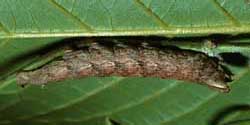 |
Erinnyis obscura, the Obscure Sphinx,
WO
Larvae feed on Rauvolfia ligustrina, Rauvolfia tetraphylla,
Stemmadenia obovata, Philibertia, Cynanchum, papaya
(Carica papaya), Asclepiadaceae, Blepharodon mucronatum,
White vine (Sarcostemma clausum) and Morrenia odorata.
rare if presnet
|
|
 |
Hemaris diffinis
WO , the
Snowberry Clearwing or Bumblebee Moth
Larval host plants include Snowberry (Symphoricarpos),
honeysuckle (Lonicera), Coralberry, viburnums, Blue Dogbane
(Apocynum) and dwarf bush honeysuckle (Diervilla lonicera).
Horn is black with a yellow base.
|
 |
Hemaris thysbe
WO, the Hummingbird Clearwing
There is also an orangey-pink prepupal form. The lateral line runs
from S1 to the blue horn.
Hemaris thysbe larvae feed on viburnum and related plants.
generally more eastern species; maybe
|
Philampelini tribe:
 |
Larvae feed upon Grape (Vitis), Virginia Creeper
(Parthenocissus quinquefolia) and other vines and ivies
(Ampelopsis).
Larvae occur in both a light (green) form and a darker (tan/brown)
form. Note six "segmented" oblique lines.
|
 |
If you have Grape or Virginia Creeper nearby, then you might encounter
this species. Note the five large white ovals. There are
orangey-brown and green forms also.
generally more eastern species
|
Macroglossini tribe:
 |
In additon to Virginia creeper larvae accept Grape (Vitis),
ampelopsis (Ampelopsis), and cayenne pepper (Capsicum).
Larvae are green until the final instar.
|
 |
Darapsa myron
WO, the Virginia Creeper Sphinx or the Grapevine Sphinx
If you have the
foodplants indicated in the common names, you probably have this
species nearby. The lower wings are orange.
Larvae feed on Virginia creeper (Parthenocissus quinquefolia),
Grape (Vitis), Ampelopsis, and Viburnum.
|
 |
Females lay translucent green eggs singly on leaves of the host
plant. Grape (Vitis), ampelopsis (Ampelopsis), and
Virginia creeper
(Parthenocissus) all serve as larval hosts.
|
 |
Hyles lineata
WO, the White-lined Sphinx
Larvae are highly varied and feed on a great diversity of plants
including willow weed (Epilobium), four o'clock (Mirabilis),
apple (Malus), evening primrose (Oenothera), elm
(Ulmus), grape (Vitis), tomato (Lycopersicon),
purslane (Portulaca), and Fuschia.
All larvae seem, however, to have the red/black swellings split by
dorso-lateral lines.
|
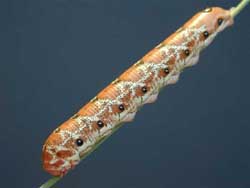 |
Larvae feed on (Onagraceae) including evening primrose
(Oenothera), gaura (Gaura), and willow weed
(Epilobium).
rare
|
 |
Larvae feed at night on grape (Vitis) and ampelopsis
(Ampelopsis) and hide on the bark of their host plants during
the day. Virginia creeper would also be a suitable host. There is also a dark form
without the green patches. Note the "raised eye", replacing the anal horn.
generally more eastern species
|
|
